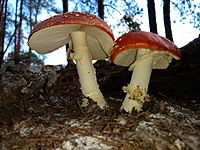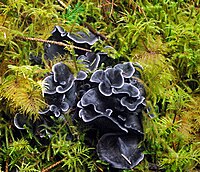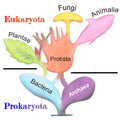Portal:Fungi
The Fungi Portal
A fungus is any member of a large group of
.Since the 1940s, fungi have been used for the production of
pathogens of humans and other animals. Losses of crops due to fungal diseases or food spoilage can have a large impact on human food supplies and local economies. Despite their importance on human affairs, little is known of the true biodiversity
of Kingdom Fungi, which has been estimated at around 1.5 million species, with about 5% of these having been formally classified.
| More about fungi... |
Selected article
leathery earthfans. A monotypic genus, it contains the single species Polyozellus multiplex, first described in 1899, and commonly known as the blue chanterelle, the clustered blue chanterelle, or, in Alaska, the black chanterelle. The distinctive fruit body of this species resembles blue- to purple-colored clusters of vase- or spoon-shaped caps with veiny wrinkles on the undersurface that run down the length of the stem
.
Polyozellus has had a varied
range of Polyozellus includes North America and eastern Asia, where P. multiplex may be found growing on the ground in coniferous forests, usually under spruce and fir trees. It is an edible species, and has been harvested for commercial purposes. Polyozellus multiplex contains the bioactive compound polyozellin, shown to have various physiological properties, including suppressive effects on stomach cancer
.
Selected species
imperfect), or conidial stage of U. craterium is the plant pathogenic species Conoplea globosa, known to cause a canker disease of oak and several other hardwood
tree species.
Things to do
If you want to help Wikipedia to improve its coverage of fungi, here are some things you can do...
- Assesssome fungi articles.
- Join Wikipedia:WikiProject Fungi or ask on the talk page.
- Join the lichen task force.
- Review, improve, expand or clean some of the newly created fungi-related articles.
- Expand some high priority fungus stubs.
- Expand or sort other fungi-related stubs.
- Add images to articles in the list of unillustrated fungi articles, or add more articles to the list.
- Write fungi-related articles from scratch. For ideas of needed articles, see the redlinks on-
- Review the fungi articles flagged as needing attention.
WikiProjects
WikiProjects related to fungi:
What are WikiProjects?
Selected picture
Did you know?
- ... that species in the dextrinoid?
- ... that colonization of mature black spruce trees by jelly drops helps protect them from future infection by rot-causing fungi?
- ... that fruiting bodyunusually resistant to decay?
- ... that the whitish powder found on the spore sac of the beaked earthstar is made of crystalline calcium oxalate?
- ... that the "wrinkled peach" mushroom requires light from the red end of the visible spectrum to induce fruiting?
General images -
The following are images from various fungi-related articles on Wikipedia.
-
Ling Zhi-8, an immunomodulatory protein isolated from Ganoderma lucidum (from Medicinal uses of fungi)
-
Amanita jacksonii buttons emerging from their universal veils (from Mushroom)
-
Lichen covered rocks(from Marine fungi)
-
protoperithecia of the opposite mating type through the trichogyne. Fusion of the nuclei of opposite mating types occurs within the protoperithecium to form a zygote (2N) nucleus. (from Mating in fungi)
-
Chytrid parasites of marine diatoms. (A) Chytrid sporangia on Pleurosigma sp. The white arrow indicates the operculate discharge pore. (B) Rhizoids (white arrow) extending into diatom host. (C) Chlorophyll aggregates localized to infection sites (white arrows). (D and E) Single hosts bearing multiple zoosporangia at different stages of development. The white arrow in panel E highlights branching rhizoids. (F) Endobiotic chytrid-like sporangia within diatom frustule. Bars = 10 μm. (from Marine fungi)
-
Mycoloop links between phytoplankton and zooplanktonChytrid‐mediated trophic links between phytoplankton and zooplankton (mycoloop). While small phytoplankton species can be grazed upon by zooplankton, large phytoplankton species constitute poorly edible or even inedible prey. Chytrid infections on large phytoplankton can induce changes in palatability, as a result of host aggregation (reduced edibility) or mechanistic fragmentation of cells or filaments (increased palatability). First, chytrid parasites extract and repack nutrients and energy from their hosts in form of readily edible zoospores. Second, infected and fragmented hosts including attached sporangia can also be ingested by grazers (i.e. concomitant predation). (from Marine fungi)
-
Thestatins. (from Medicinal uses of fungi)
-
Typical mating fusion of two compatible monokaryons in Basidiomycota (from Mating in fungi)
-
Tinea corporis (from Fungal infection)
-
meltpond, infected with two chytrid-like [zoo-]sporangium fungal pathogens (in false-colour red). Scale bar = 10 µm. (from Marine fungi)
-
Roles of fungi in the marine carbon cycleRoles of fungi in thebiological carbon pump. (from Marine fungi)
-
The photochemistry of vitamin D2 biosynthesis (from Medicinal uses of fungi)
-
Agaricus bisporus, one of the most widely cultivated and consumed mushrooms (from Mushroom)
-
Pityriasis versicolor (from Fungal infection)
-
Group photograph taken at a meeting of the British Mycological Society in 1913 (from Mycology)
-
Close-up cross section of mushroom. (from Mushroom)
-
Amanita muscaria, the most easily recognised "toadstool", is frequently depicted in fairy stories and on greeting cards. It is often associated with gnomes. (from Mushroom)
-
Ganoderma lingzhi (from Mushroom)
-
Yellow flower pot mushrooms (Leucocoprinus birnbaumii) at various states of development (from Mushroom)
-
Young Amanita phalloides "death cap" mushrooms, with a matchbox for size comparison (from Mushroom)
-
There are over 100 psychoactive mushroom species of genus Psilocybe native to regions all around the world. (from Mushroom)
-
Mushrooms are considered a kind of fungal reproductive organ. (from Mycology)
-
Oral candidiasis (from Fungal infection)
-
Agaricus bisporus mushroom is a cultivated edible mushroom for foods and has many names such as "champignon", " button mushroom", "white mushroom", and " portobello" (from Mushroom)
-
Morphological diversity of fungi collected from a marine sponge species, Ircinia variabilis (from Marine fungi)
-
Onychomycosis (from Fungal infection)
-
Fungi within Zygomycota form progametangia with suspensors during mating (from Mating in fungi)
-
phase contrast microscopy (from Mushroom)
-
Eumycetoma (from Fungal infection)
-
Culinary mushrooms in a diversity of shapes and colors (from Mushroom)
-
A mushroom (probably Russula brevipes) parasitized by Hypomyces lactifluorum resulting in a "lobster mushroom" (from Mushroom)
-
Psilocybe zapotecorum, a hallucinogenic mushroom (from Mushroom)
-
Salmon withfungal disease (from Marine fungi)
-
Maitake, a polypore mushroom (from Mushroom)
-
Psychotropic mushroom Amanita muscaria, commonly known as "fly agaric" (from Mushroom)
-
Common puffball (Lycoperdon perlatum) has a glebal hymenium; the interior is white when it is young, but as it matures, the interior becomes brown containing spores (from Mushroom)
-
Diagram of a mycoloop (fungus loop)Parasiticpolyunsaturated fatty acids and cholesterols). Large colonies of host phytoplankton may also be fragmented by chytrid infections and become edible to zooplankton. (from Marine fungi)
-
Driftwood(from Marine fungi)
-
Fungi within Ascomycota form ascogonium and antheridium with trichogyne bridge (from Mating in fungi)
-
A tinder fungus, Fomes fomentarius (from Mushroom)
-
Phylogenetic and symbiogenetic tree of living organisms, showing a view of the origins of eukaryotes and prokaryotes (from Marine fungi)
-
Morphological characteristics of the caps of mushrooms (from Mushroom)
Related portals
Topics
- Main topics lists: Outline of fungi and Outline of lichens
- pathogenic fungi, puffball, wood-decay fungus
- Fungal orders: Chytridiomycota, Blastocladiomycota, Neocallimastigomycota, Zygomycota, Glomeromycota. Dikarya: Ascomycota, Basidiomycota
- Fungi lists: Species: psilocybin mushrooms


















![Image 13Pennate diatom from an Arctic meltpond, infected with two chytrid-like [zoo-]sporangium fungal pathogens (in false-colour red). Scale bar = 10 µm. (from Marine fungi)](http://upload.wikimedia.org/wikipedia/commons/thumb/b/b5/Pennate_diatom_infected_with_two_chytrid-like_fungal_pathogens.png/120px-Pennate_diatom_infected_with_two_chytrid-like_fungal_pathogens.png)












































